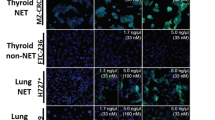Abstract
Botulinum toxins are known to block transmitter release at peripheral cholinergic synapses1, producing muscular weakness and paralysis. The toxins may also block adrenergic transmission2–5, although this effect is less well understood1. The mechanisms by which toxins act are unclear. They are proteins of relative molecular mass ∼150,000 and are structurally similar to tetanus toxin. It is generally accepted that a rise in intracellular calcium concentration is sufficient to trigger secretion by exocytosis6–13, but it is not known whether the toxins block secretion by preventing this Ca transient14,15 or whether they act downstream from Ca entry by interfering with the process of exocytosis itself. We have attempted to resolve these questions in the case of the adrenergic system by studying the effects of botulinum toxins (types A, B, D and E) on the secretory response of isolated bovine adrenal medullary cells maintained in culture16. The cells were either challenged with various secretagogues or rendered leaky and challenged directly with Ca buffers. We report here that botulinum toxin type D inhibits secretion in a time- and dose-dependent manner, the results being entirely consistent with the idea that the toxin acts at or near the site of exocytosis rather than at the sites controlling the rise in free Ca.
This is a preview of subscription content, access via your institution
Access options
Subscribe to this journal
Receive 51 print issues and online access
$199.00 per year
only $3.90 per issue
Buy this article
- Purchase on Springer Link
- Instant access to full article PDF
Prices may be subject to local taxes which are calculated during checkout
Similar content being viewed by others
References
Simpson, L. L. Pharmac. Rev. 33, 155–188 (1981).
Rand, M. J. & Whaler, B. C. Nature 206, 588–591 (1965).
Westwood, D. A. & Whaler, B. C. Br. J. Pharmac. Chemother. 33, 21–31 (1968).
Bond, J. C. Fedn Proc. 28, 415 (1969).
Holman, M. E. & Spitzer, N. C. Br. J. Pharmac. 47, 431–433 (1973).
Douglas, W. W. & Rubin, R. P. J. Physiol., Lond. 167, 288–310 (1963).
Katz, B. & Miledi, R. J. Physiol., Lond. 192, 407–436 (1967).
Miledi, R. Proc. R. Soc. B183, 421–425 (1973).
Llinas, R., Steinberg, I. Z. & Walton, K. Biophys. J. 33, 323–352 (1981).
Miledi, R. & Parker, I. Proc. R. Soc. B212, 197–211 (1981).
Baker, P. F. & Knight, D. E. Phil. Trans. R. Soc. B296, 83–103 (1981).
Knight, D. E. & Kesteven, N. T. Proc. R. Soc. B218, 177–199 (1983).
Baker, P. F. & Knight, D. E. Trends Neurosci. 7(4), 120–126 (1984).
Hirokawa, N. & Heuser, J. E. J. Cell Biol. 88, 160–171 (1981).
Gunderson, C. B., Katz, B. & Miledi, R. Proc. R. Soc. B216, 369–376 (1982).
Mizobe, F., Kozousek, V., Dean, D. M. & Livett, B. G. Brain Res. 178, 555–566 (1979).
Knight, D. E. & Baker, P. F. Q. J. exp. Physiol. 68, 123–143 (1983).
Duchen, L. W. & Tonge, D. A. J. Physiol., Lond. 228, 157–172 (1973).
Bevan, S. & Wendon, L. M. B. J. Physiol., Lond. 348, 1–17 (1984).
Dolly, J. O., Black, J., Williams, R. S. & Melling, J. Nature 307, 457–460 (1984).
Williams, R. S., Tse, C-K., Dolly, J. O., Hambleton, P. & Melling, J. Eur. J. Biochem. 131, 437–445 (1983).
Simpson, L. L. Brain Res. 305, 177–180 (1984).
Simpson, L. L. J. Pharmac. exp. Ther. 229, 182–187 (1984).
Baker, P. F. & Rink, T. J. J. Physiol., Lond. 253, 593–620 (1975).
Baker, P. F. & Knight, D. E. Nature 276, 620–622 (1978).
Knight, D. E. & Baker, P. F. J. Membrane Biol. 68, 107–140 (1982).
Author information
Authors and Affiliations
Rights and permissions
About this article
Cite this article
Knight, D., Tonge, D. & Baker, P. Inhibition of exocytosis in bovine adrenal medullary cells by botulinum toxin type D. Nature 317, 719–721 (1985). https://doi.org/10.1038/317719a0
Received:
Accepted:
Issue Date:
DOI: https://doi.org/10.1038/317719a0
This article is cited by
-
Distinct patterns of exocytosis elicited by Ca2+, Sr2+ and Ba2+ in bovine chromaffin cells
Pflügers Archiv - European Journal of Physiology (2018)
-
Evidence implicating protein kinase C in exocytosis from electropermeabilized bovine chromaffin cells
The Journal of Membrane Biology (1988)
-
Molecular mechanisms of exocytosis: The adrenal chromaffin cell as a model system
Cellular and Molecular Neurobiology (1988)
Comments
By submitting a comment you agree to abide by our Terms and Community Guidelines. If you find something abusive or that does not comply with our terms or guidelines please flag it as inappropriate.



